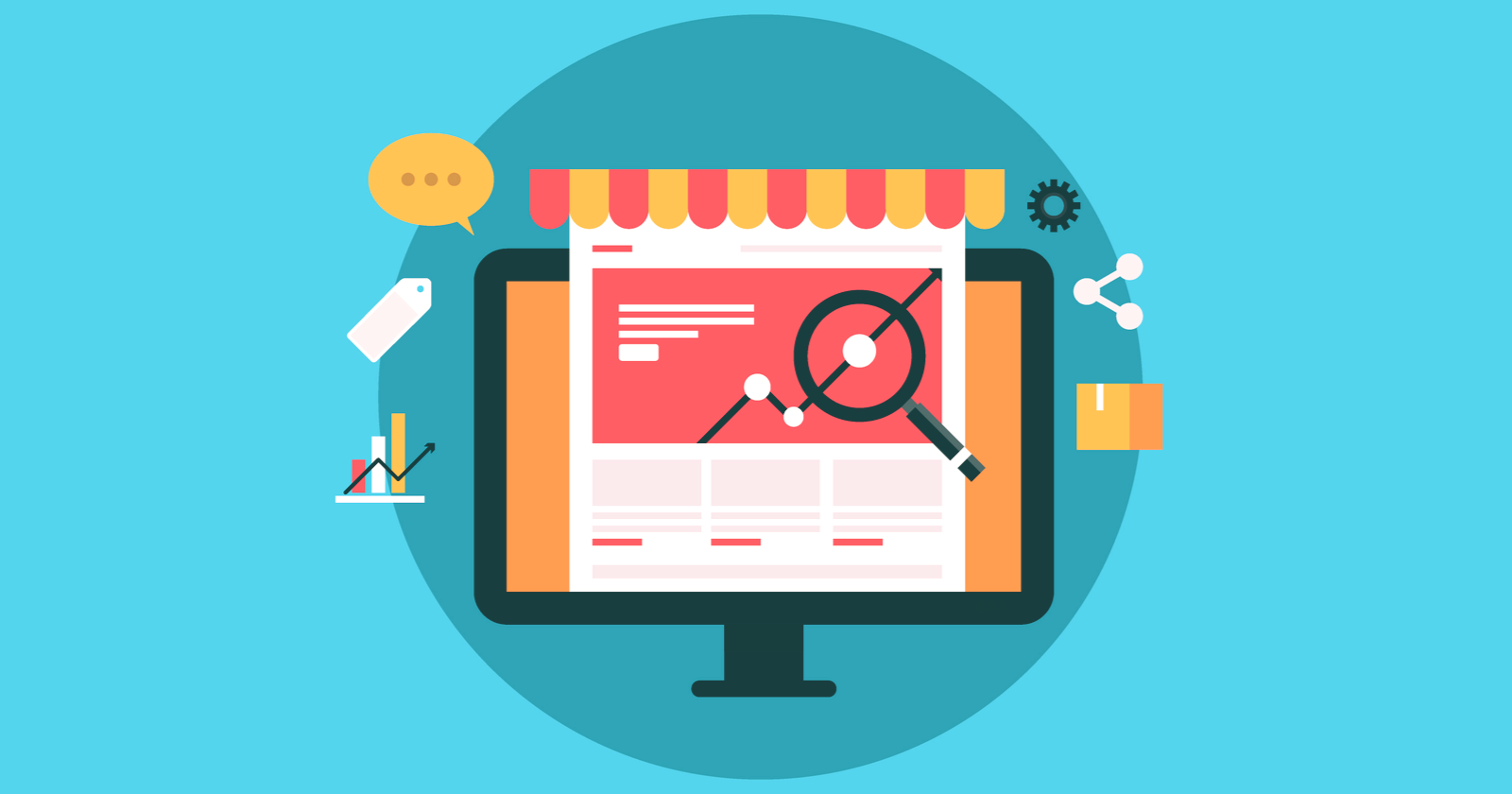
Having a well-optimized E-commerce website is a must when you are retailing products and want to reach a large audience.
You must be wondering why? Well, there are lots of benefits.
A well-panned e-commerce website can help you in understanding certain basic information of your customers like their age groups, locations, and many more. Not only this, with the help of tracking you can even use your visitor’s information for detailed analysis of their behavior.
There are many more things an e-commerce website does. It enables you to get an idea of anything going wrong. Let’s say, for example, you can know which traffic sources are not working, which offers are not appealing, and many other issues.
The worldwide growth of e-commerce is an obvious reason for optimizing your site. It has been rapidly increased and it can be predicted to keep growing year on year, and likely to continue.
One more thing is that, if you are already online, then definitely it’s great for you. But still, there is a risk of remaining invisible to new leads and fresh prospects if necessary steps are not taken to increase visibility.
If you want to generate more traffic and revenue for your eCommerce website then, follow the best SEO strategies mentioned below.

There is a large number of articles and blogs covering the tutorials regarding SEO tips for eCommerce sites, but that is very few highlighting the specific needs of e-commerce entrepreneurs.
We are here to provide you a basic understanding of the search engine optimization strategy for an e-commerce website. It is enough to kick-start and assure of sending all the right signals to Google and set you up for SEO success.
Let’s dive in.
Ecommerce SEO is a method of making your online store visible on various search engine results pages (SERPs). You want to rank high as possible and get more traffic for your site when people search for products that you sell.
You can achieve your required traffic from paid search, but why spend more, if SEO techniques cost less. Along with that, the effectiveness of paid search can be reduced by ad blindness and ad blockers, and anyhow you will need to optimize for search.
In general, an eCommerce SEO involves optimizing your product descriptions, metadata, interlink structure, headlines, and navigational structure for search and user experience. The particular product that you sell, should have a dedicated page designed to generate traffic from search engines.
The SEO marketing campaign for e-commerce helps web retailers to get high rankings in search engine results. An optimized and well-planned website with quality content is more likely to rank better in the Google search engine. As a result, it increases visibility and generates more traffic for your eCommerce stores.
In other words, SEO for eCommerce mainly focuses on optimizing your site, which makes it easy for lead generation and conversions. Moreover, SEO for eCommerce is more than writing blog posts, adding keywords, and gaining links unlike SEO for content-focused websites. You need to know about the working process of search engines and what they reward.
It clearly means having proper knowledge regarding SEO for e-commerce, as per Google’s guidelines, analyzing the intent of buyers, and implementing in a perfect way.

Now, the question comes, what exactly comes to the mind of consumers, when they require a service or product? Many of them follow Google searches. Along with that, they look for other options, tips, comparisons, and other information for making a good decision.
You can lose interested eCommerce customers and critical access to qualified if your website does not appear in the SERPs. Maybe your products are capable of being on the internet but are they searchable?
This is where eCommerce search engine optimization comes into action. It enables you to reach your target audience without spending your money on any ads. Once you achieve the particular audience to your site, you can offer them your quality products, intriguing copy, and motivating calls to action.
If you only follow website optimization for people, this can be a disservice to your company. SEO for an e-commerce website gives direction to the first hurdle in achieving new customers which is bringing people to your website.
How to Develop an Ecommerce SEO Strategy
Ecommerce SEO strategies might look a bit tough, especially if you already have a website having tons of products. The truth is, it might take some time, but you can fasten up the process by implementing best SEO practices.
Here are few effective Ecommerce SEO Practices :
Keep reading to know more about eCommerce SEO best practices.
An image like below to be designed with headline “ Best Practices for Ecommerce Strategy”

Let’s find out some of the best SEO tactics for eCommerce sites that are lacking in the area of SEO. You need an eCommerce Seo Strategy so that people can find your products or services easily. On the other hand, checking each item off your list will make your Seo practices more effective.
Well, keywords matter a lot. Even if you don’t want to overload your product titles and descriptions with these keywords, but they should be present in the copy.
Make sure to prefer your primary keyword in your product description, headline, image alternate attributes, meta description, and subheadlines. Use Latent Semantic Index (LSI) keywords throughout the website. These are the related keywords that help Google to understand your page in context.
Before using the right keyword, you need to do certain research on it. Find out how people search for it (keyword search volume), what people are looking for while using that keyword(user intent), and how competitive it is in the paid advertising space (cost-per-click, or CPC).
Usually, search volume displays the amount of interest a particular keyword used in the consumers. Higher is the search volume, the greater is the popularity, which means you’ll acquire more active searches for that keyword.
User intent refers to what people look for when they type for a specific keyword in Google’s search bar. Let’s say, for example, that a person types “marketing” and click Enter.
Here, does that person want information about online marketing, offline marketing, Social media marketing, or something else? If you can’t find out the user intent for a keyword, then you can add other words for clarity.
Finally, comes CPC(cost per click), which shows how many people pay per click while buying an ad on a specific keyword. A high CPC indicates tells about an increase in competition. If your target keyword is highly competitive, then you can go for a long-tail alternative.
If you are still confused and thinking about where to start with on-site optimization for your eCommerce site then, then your competitors are best to go.
You can learn many secrets regarding their websites, as these larger competitors have already created a benchmark for optimizing their websites. Basically, you need to focus on keywords. Particularly, analyzing the keywords on their top product pages along with their homepages.
Now, how can you detect about the website is optimizing for a particular keyword? Start by using the Moz browser extension to see the SEO description and title which your competitors are using their title tags.
You can even use other tools such as SEMrush to see the particular keywords your competitors are ranking for on both paid and organic searches. Never stop your keywords research. Find out your competitors’ landing pages as well in order to see how they are using specified keywords to optimize those pages.
Focus on Homepage SEO
Usually, the homepage is where most business owners focus their SEO budget and energy. As it is one of the top pages of your website to optimize, it means you should give the only focus on it.
You do want to optimize the home page in a perfect way as said. Here are few things that you can include and optimize.
Homepage Title Tag
The SEO title tag is considered to be one of the most important elements of on-site search optimization. It should include your business name with the main keyword phrase you are targeting. The title tag you wrote must not exceed 70 characters and it should be appealing to search visitors, as it remains in search results.
Homepage Meta Description
Unlike Title tag, it is not important as far as keyword rankings, the meta description for your homepage is usually a description of a 160-character of your business, that is displayed in search beneath the title tag. It should be written in a way that motivates people to visit your website.
The homepage content should help visitors to give more information about your business and the products that you offer in a clear and brief way. Never overload the visitors with much information. Make sure to feature your top new products on the homepage and your unique theory of selling.
Homepages that are cluttered can really confuse the visitors as well as search engines. For example, you may be selling products in various categories. It will be difficult for Google to identify which product you are selling and whom you are actually targeting with your products, so be specific about what your site offers.

While adding categories and products to your store, remember one thing, that site planning plays a key role in search optimization. Especially when you wish to have a well-defined hierarchy of navigation, from your homepage to product categories to the products listed within them.
Based on a clear linking structure, search engine bots will discover your pages and products on your website, which is easy to follow and not that deep.
For search engines and visitors the rule thumb is to make sure people can reach the entire thing within three clicks. They should only need to make a maximum of three clicks on your website to find any product from the homepage.
Internal Linking
Internal links have two main purposes in your website:
Linking to informative blog articles and related products can help in improving e-commerce SEO and make your site more appealing.
Optimize Product Pages
You need to focus on a lot of your energy to optimize your product pages, as they are very necessary for your business. Most of the eCommerce store owners just mention few lines regarding their product and add an image or video.
You need to provide more information on your product pages so that Google can reach them.
Here are the following that you can include.
Product Name
Product name is very important for your e-commerce site. It has also been used as the SEO title and URL of your product page in most cases. That’s the reason, you might consider adding keyword phrases or a common search term to your products.
Let’s say, you are selling T-shirts, then in this case you must include “tee” or “T-shirt” in the product name. This way, the keyword also ends up in the URL and SEO title.
In addition to that, while sharing your products by the people on Facebook or any other platforms, that particular keyword remains in the title of the shared post.
Image Optimization

Images are also very much essential for your product page. Be in your customer’s shoes and think for a moment. Do you feel like buying the product from a site that clearly portrays the product that does not have an image and from as many angles as possible, or from one that is illegible and small?
Not only are the images important for search optimization but also for your customers. For optimization of your images for search, begin with the filename. Do not add images to your product page by naming them as IMG0010.jpg. Instead of that, you can use the main keyword and the product name.
Include the keywords that people would use while searching for the images in search if you have alternative views of your product.
Include the product name and keyword in the ALT text for the image when you adding your images to the product page.
As a result, your images will have more chances to appear in Google Image Search or the main search results page as a part of an extra media showing.
Make your customers be more confident about their purchases by adding video to your product page. The video can relate to the basic information about your product (like a commercial), testimonials from people who have already used your products, or videos related to how to use the product to get results.
Publishing your videos on networks such as YouTube could be great to educate and attract potential customers about your products. You can include DIY videos related to education say, for example, you can show people how to create something unique by including your products. Once they get an idea of working on that, there is more chances that they will buy your products.
Customer Reviews
Reviews have always been an essential factor in boosting customer confidence in your product, so make sure to allow them if you have good products.
On the other hand, even bad reviews are not always bad, seriously think about that. Like if you have higher-priced products having great reviews and lower-priced products with not-so-good reviews, then naturally people will be more likely to select the higher-priced product, resulting in boosting your sales for your business.
FAQ Content
Are you thinking about people inquiring about your products? Of course, they do. So, it is important to have product-specific FAQ content on your product pages as it is the key to conversion.
Keep in mind that, if you don’t reply to customer’s questions, then they will be going somewhere else to find those answers. This will make them buying from the source that answers their questions.
Well, you can even have a general FAQ page on your website. Giving relevant replies and answers to the customers regarding the website’s shipping, return policies, and security can boost the confidence of buyers and result in more revenue.
Use Responsive Design
Nowadays, people of every age do online shopping through mobile. By using a responsive design for your eCommerce website can not only improve the search results but also lead to a better user experience.
Reduce Page Load Speed
Page load speed acts as a ranking signal, for both mobile and desktop. The faster your page is loaded the better Google ranks your website.
So, how can you reduce page load speed? Focus on decreasing unnecessary elements from your page. For example, a large background image that is mostly covered by a white body column may not be necessary.
In the same way, remove any add-ons or plugins that are not related to your eCommerce business’s bottom line.
Image size and dimension affect the loading time of your image. Because the larger is the image, the longer a browser takes to load it. For example, if you have decreased an image’s size from 1,000×1,000 pixels to 500×500 pixels, then it is decreased its “weight” by half. With the help of programs like Adobe Photoshop, you can also save your images as lower-quality JPG (JPEG)s.
Build Backlinks for Ecommerce SEO
Backlinks are yet another ranking signal used by Google in order to find at which place your pages belong in the SERPs. The more backlinks you get from high-quality sites, the more your website becomes trustworthy.
Creating backlinks for e-commerce sites is not that tough. Guest posting on blogs regarding your ideal position is an easy process and a white-hat way to create links. You just need to email the blog owners about your interest and offer them some ideas for potential guests posts.

Are you are looking for the right tools that can work best for your e-commerce SEO strategy? You are at the right place. We bring you some of the best ways that can help to boost your on-page and off-page SEO for higher visibility in the search engines.
MOZ is an ideal tool to find link-building opportunities, track and find the keywords and analyze competitors’ page metrics. They are available in both free and paid versions so that it will be easier for you to decide what will be best for your eCommerce SEO campaign.
Ahrefs is mainly used to optimize and track your eCommerce SEO practices. It is a great tool to find the backlinks to your site along with your competitors’ sites. In case if someone has linked to your competitor then it might be tough to link your own site by emailing that person and establishing a mutual understanding.
You can offer to link to his or her site, thereafter suggesting one of your high-quality posts that could be interesting for the audience.
ScreamingFrog
ScreamingFrog is a great tool for finding issues on your sites, such as missing meta descriptions, duplicate content, and broken links. Like, the time when you identify such issues, create redirects or add missing content, you don’t get penalized in the search engines. The free version of ScreamingFrog offers a wide range of useful tools, but in case you have URL extensions exceeding 500, you might want to go for a premium.
Ubersuggest is a highly beneficial tool for finding related keywords to boost your rankings and isolating the best keywords to target for your e-commerce website.
Just type a keyword related to your product and Ubersuggest will drag various sources on the web for information related to your keywords, search volume, CPC, and many more.
There are many eCommerce business owners who just want to jump straight to increase their site visibility. In fact, it’s a correct mindset and but, you are a step ahead.
Just follow the above eCommerce SEO strategies and get the maximum audience to your site. With the help of effective tools for eCommerce, SEO practices and benefit your site. Simply start with e-commerce SEO that sets you up for success.
Let’s check out our checklist for eCommerce SEO:
Follow these steps, and your eCommerce site will rank better in the search engines and result to generate more leads.
Get in touch with us to know more about digital marketing agencies.
Hope it helps!
